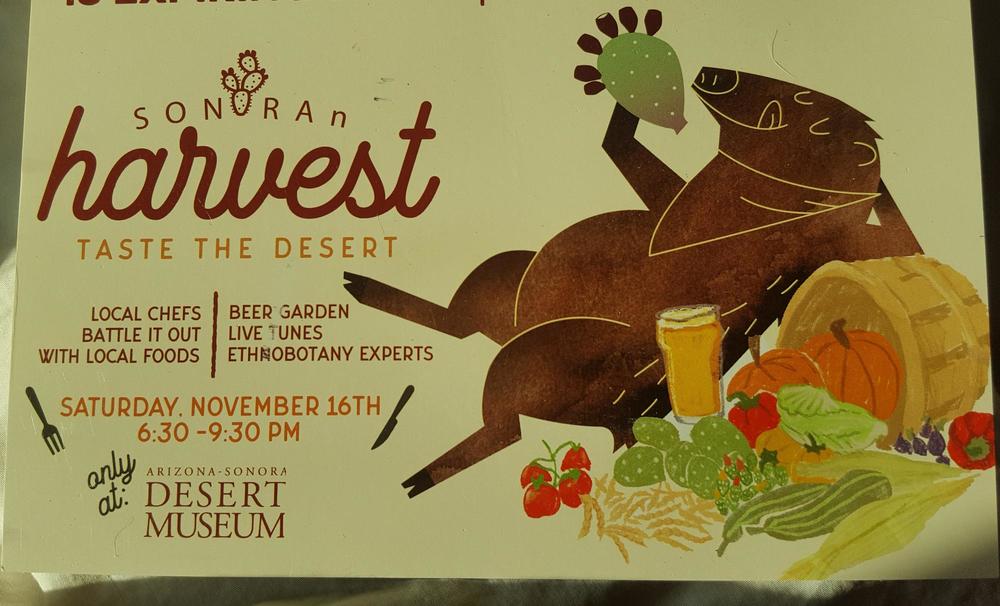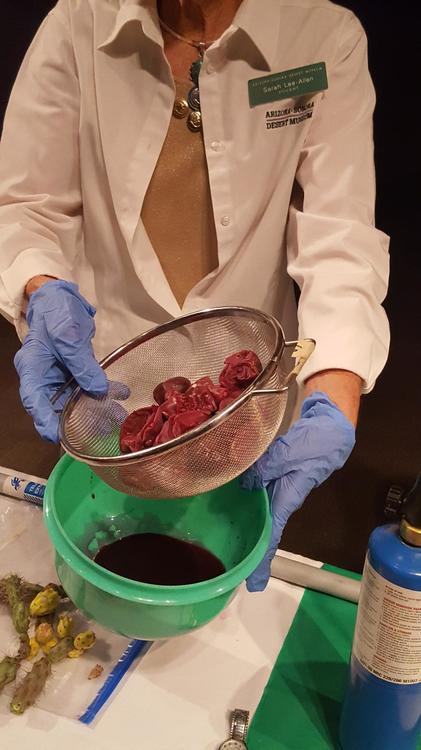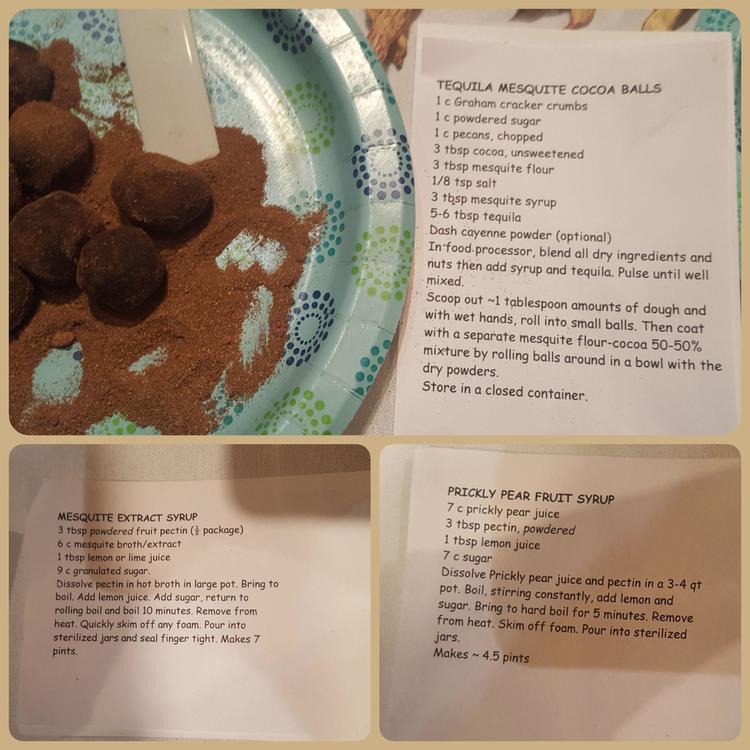I got the card announcing the 2nd Annual Sonoran Harvest festival at the Arizona Sonoran Desert Museum.
I thought long and hard before deciding to go. As I noted last year, the first festival was so disorganized that I was disappointed in much of it. Still, there had been bright spots. Maybe this year would be better as they got the kinks worked out. Furthermore, I'd focus on the food. Never mind the animal enrichment shows, unless I could fit them in; first things first!
It was better. This year I thought I got my money's worth, even though the price for admission, food and beer had gone up from $45(?) to $60. I'll tell the story in several stages rather than one long post as last year.
The first bright spot was that the energetic and inimitable Sarah Lee-Allen, whose presentation features harvesting and processing Sonoran foods with "A Pot, Pillowcase, Blender & Butane", was a featured speaker in the auditorium. Last year I stumbled over her display at a small table somewhere along some trail. This year she had a sound system, an overhead projector, a large table and a specific time slot.
This is what I mean about how animated she is!
She is a funny speaker and told great stories as she illustrated her points. When she talked about harvesting fruit from the saguaro cactus, she noted that the Tohono O'odham harvest it with a tool called a kukuipad that is made from the ribs of dead saguaro. You can see a picture of one here, in the lower right photo. Removing the fruit involves a twisting motion, not cutting, and the cross-member at the end of the pole is the trick. She explained that she didn't have one of those, but she has a clever husband who assembled a telescoping metal pole and a paint roller holder to do the same work. "And when it was all done," she said, "we were ready to paint the house!" ![]()
She talked about harvesting prickly pear fruit and how to process it. There's been quite a bit of discussion, some in this topic and some in the Foraging for Favorites topic, about my recent experiments with it. Some things she said were valuable information. She rinses the tunas a few times before bringing them into the house; that eliminates a lot of the glochids and keeps them from being tracked into the house or making a mess of the sink. Then she whirrs the fruit in a blender and strains it all through a pillowcase. She used to use multiple layers of cheesecloth, multiple colanders, and multiple straining stages. Then she realized that a pillowcase would do the same trick. It's a good shortcut, she said. She went on with cautionary notes: yes, you can reuse the same pillowcases, year after year, BUT...(a) turn them inside out and shake them outside, well away from the house, lest you inadvertently plant a bunch of seeds nearby; (b) wash them and do a double rinse of the laundry; else you'll end up with traces of pulp and glochids and seeds inside your washing machine. "Do not shortcut the shortcuts!" she cautioned, more than once.
Toward the end of the class, when we were all crowding around the table and tasting samples, she asked whether anyone had tried the freezing method. I said I had, with little juice gotten out of the process, and I'd had to steam the fruit instead. "The fruit has to be frozen all the way through to disrupt the cell structure," she said. I think the Princessmobile's freezer just doesn't get cold enough. She also said that in side-by-side taste tests of juice extracted from frozen tunas vs. juice filtered from blended tunas, she and a class had thought the blended and filtered tunas produced a brighter juice. I don't remember what she said about steaming, other than that she didn't prefer that method.
She processes hundreds of pounds of prickly pear fruit during the season (she has a dedicated freezer for the pulp and the filtered juice) and they drink some every day. She asserts that her husband's cholesterol dropped dramatically, to the point of no longer needing medicines, some months after they had begun their daily cuppa. Jay, her husband, has come up with some excellent recipes for using the juice. I still have to try making his prickly pear ice cream, but I carry the recipe with me.
Other harvest treats were smoked cholla buds and three syrups (mesquite, prickly pear, and saguaro) that I didn't manage to photograph but I tasted or smelled. What I remember about the mesquite harvest and getting syrup from it is that you need the flavor from the pith of the pod. Don't bother popping those pods open and scraping them! Throw them into a pillowcase and crack them, then dump the lot into water to boil. Filter the remains in the pillowcase. To see which mesquite gives you the best flavor, taste them. If you don't like the flavor, don't mess with it any more. Velvet mesquite and Texas' honey mesquite are the preferred varieties, in her view.
One cautionary note at this point was that mesquite pods that have been lying on the ground can develop a fungus that, if ingested, will ruin your day and maybe your life. You should be picking the dried pods from the tree instead of picking them up off the ground. Unfortunately for her, the gardener in her neighborhood trims the trees higher than she can reach! To get around that, she waits until the day after the gardener has come by and cleaned up under the trees. The next morning, whatever is lying on the ground is still safe; it's only been there overnight.
Her smoked chollim smelled wonderful, but I didn't make notes on how she did that. I did take tastes of these tequila mesquite cocoa balls, though. I plan to try making these. Won't they make a good holiday treat? They're a nice twist on the cocoa rum balls of my early 20's.








